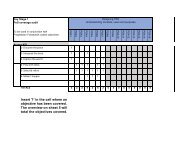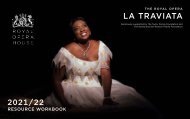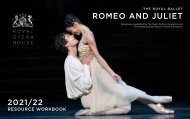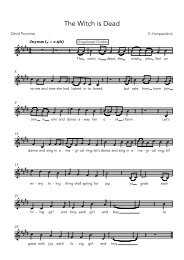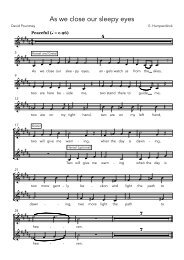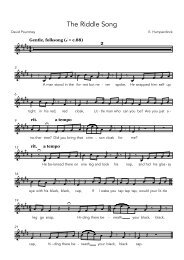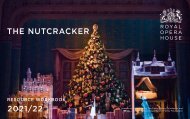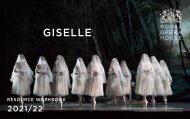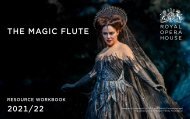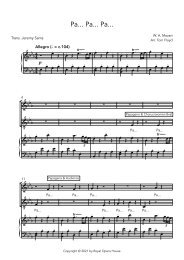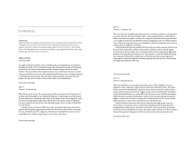Infra E-resource pack 2018
You also want an ePaper? Increase the reach of your titles
YUMPU automatically turns print PDFs into web optimized ePapers that Google loves.
EXTRA INFORMATION<br />
114<br />
THE ROYAL BALLET – COMPANY STRUCTURE<br />
There are different ranks within a ballet company, giving dancers a range<br />
of opportunities for development. The terminology varies between ballet<br />
companies for these different grades. The Royal Ballet has five main dancing<br />
ranks as well as a senior actor/dancer rank.<br />
Anti-clockwise from top left:<br />
Gary Avis as Drosselmeyer<br />
in The Nutcracker ©ROH/Bill<br />
Cooper, 2012<br />
Alastair Marriott and<br />
Jonathan Howells as the<br />
Stepsisters in Cinderella<br />
©ROH/Tristram Kenton, 2011<br />
Carlos Acosta in Don Quixote,<br />
©ROH/Johan Persson, 2013<br />
Left to right:<br />
Artists of The Royal Ballet and<br />
Royal Ballet School in Swan Lake,<br />
Act II ©ROH/Bill Cooper, 2011<br />
Royal Ballet First Soloist, Claire<br />
Calvert, ©ROH/Bill Cooper, 2014<br />
Sarah Lamb as Princess Aurora<br />
and Steven McRae as Prince<br />
Florimund in The Sleeping Beauty<br />
©ROH/Johan Persson, 2011<br />
11. Divertissements – A classical<br />
ballet term meaning ‘enjoyable<br />
diversion’. These short dances<br />
are typically added to a ballet to<br />
display the dancers’ talents either<br />
as soloists, in duets or in groups.<br />
See Appendix A for full glossary.<br />
Artists and First Artists<br />
form the corps de ballet.<br />
This is a term used to<br />
express the ‘body’ or group<br />
of a ballet that fulfils a<br />
similar function to that of<br />
the chorus in an opera. It<br />
refers to those dancers<br />
who generally perform the<br />
group dances as opposed<br />
to the solo dances. In many<br />
of the standard classics<br />
these dancers perform<br />
roles such as villagers,<br />
swans, snowflakes and<br />
courtiers and you will<br />
see them form the lines<br />
and group patterns of<br />
the choreography. The<br />
First Artists have usually<br />
been in The Royal Ballet<br />
longer than the Artists and<br />
may feature a bit more<br />
prominently, for example at<br />
the front of lines or leading<br />
the other dancers.<br />
Soloists have the<br />
opportunity to dance<br />
solo roles in the repertory,<br />
for example within<br />
‘divertissements’ 11 in a<br />
ballet. First Soloists also<br />
perform solo roles and<br />
additionally may have the<br />
opportunity to understudy<br />
and perform some of the<br />
principal roles in a ballet.<br />
Soloists and First Soloists<br />
are also featured in pas de<br />
deux and pas de trois in<br />
the repertory, such as the<br />
Bluebird pas de deux in<br />
The Sleeping Beauty.<br />
Principal is the senior rank<br />
of The Royal Ballet. This is<br />
the most sought-after level,<br />
reserved for those dancers<br />
who exhibit supreme<br />
qualities of artistry,<br />
musicality and technique.<br />
These dancers perform<br />
signature roles in the<br />
Company’s repertory – for<br />
example Princess Aurora<br />
and Prince Florimund<br />
in The Sleeping Beauty,<br />
Crown Prince Rudolf in<br />
Mayerling, and Queen<br />
Hermione and King Leontes<br />
in The Winter’s Tale – as<br />
well as leading roles in<br />
abstract ballets.<br />
Principal Character Artists<br />
are senior members of the<br />
Company who perform<br />
roles that require acting<br />
as well as dancing skills.<br />
Such roles include the<br />
magician Drosselmeyer in<br />
The Nutcracker and the<br />
Nurse in Romeo and Juliet.<br />
Photograph example of the<br />
Principal Character Artists<br />
mentioned above.<br />
Guests from other<br />
companies around<br />
the world who dance<br />
occasionally with The<br />
Royal Ballet are called<br />
Guest Artists. Many Royal<br />
Ballet Principals also<br />
perform abroad and are<br />
internationally acclaimed.<br />
Progression through the<br />
ranks is not automatic<br />
and many dancers flourish<br />
lower down in the ranks for<br />
their entire career dancing<br />
a wonderful variety of<br />
repertory. The ranks can<br />
also be fluid – for example,<br />
a choreographer may select<br />
an Artist or First Artist to<br />
feature in solo and even<br />
principal roles. Some ballets<br />
feature all dancers equally<br />
without any hierarchy.<br />
In addition to the ranks<br />
described above, The<br />
Royal Ballet has a one-year<br />
level when they first join.<br />
They work alongside the<br />
corps de ballet and receive<br />
specialist mentoring and<br />
coaching.<br />
Students at The Royal<br />
Ballet School dance<br />
with the Company and<br />
perform roles such as<br />
cygnets, pages and<br />
party children as well as<br />
various walk-on parts.<br />
The older students dance<br />
with the corps de ballet,<br />
and talented graduates<br />
are selected to join the<br />
apprenticeship scheme of<br />
The Royal Ballet or other<br />
leading international ballet<br />
companies.<br />
Note: When watching<br />
Wayne McGregor’s <strong>Infra</strong>,<br />
you may observe that<br />
he has not followed the<br />
traditional hierarchical<br />
ballet structure when<br />
choreographing and<br />
casting the piece. Male<br />
and female dancers have<br />
equal roles and there isn’t<br />
one main principal dancer<br />
supported by the separate<br />
apprenticeship scheme<br />
and many of the new<br />
dancers to the Company<br />
are contracted as this





